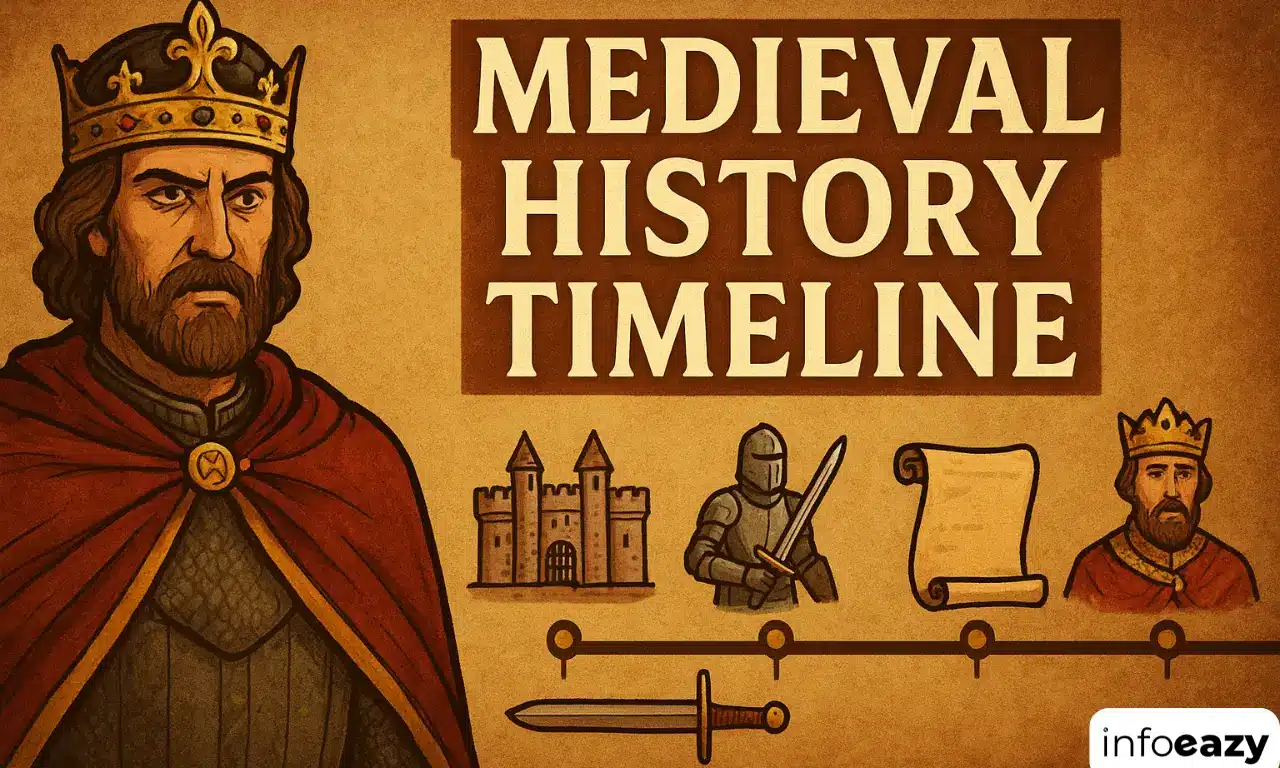History is a significant subject for the various National & State Competitive Examinations, as it tests the aspirant’s understanding of India’s past, governance, art, culture, and socio-economic developments. The history syllabus is broadly divided into Ancient, Medieval, and Modern history. While questions from Ancient and Modern India have always been consistent in various national & state-level government exams.
Medieval History Timeline
The Medieval Period in India spans from the 8th to the 18th century and is subdivided into:
- Early Medieval Period (8th-13th century) – marked by the growth of regional kingdoms, temple architecture, and early Islamic invasions.
- Later Medieval Period (13th-18th century) – characterized by the Delhi Sultanate, Mughal Empire, Vijayanagar and Deccan kingdoms, Sikh Gurus, and European trade influence.
The following timeline covers the major events, battles, rulers, and cultural milestones in Medieval India, essential for UPSC preparation.
Early Medieval Period (8th-13th Century)
During the early medieval period, India was divided into multiple states and kingdoms, each striving for political supremacy. The major powers included the Rashtrakutas, Pratiharas, Palas, and Cholas, who influenced both northern and southern India.
| Early Medieval Period (8th-13th Century) | ||
| Year | Event | Significance |
| 712 | First invasion of Sindh by Mohammed-bin-Qasim (Arabs) | Introduced Islam in the Indian subcontinent; Sindh became the first Muslim territory in India. |
| 836 | Accession of King Bhoja of Kannauj | Bhoja strengthened cultural and political influence in North India. |
| 985 | Accession of Rajaraja Chola | Rajaraja expanded the Chola Empire to South India and Sri Lanka, initiating temple-building projects like Brihadeeswarar Temple. |
| 998 | Accession of Sultan Mahmud Ghazni | Ghazni became the ruler of Ghazni (Afghanistan) and initiated repeated raids into northern India. |
| 1001 | First invasion of India by Mahmud Ghazni; defeated Jaipal of Punjab | Marked the beginning of large-scale plundering campaigns targeting wealth and temples. |
| 1024 | Destruction of Somnath Temple by Mahmud Ghazni | Symbolic of the repeated attacks on Hindu temples by Ghazni to assert dominance and accumulate wealth. |
| 1191 | First Battle of Tarain (Prithviraj Chauhan vs Muhammad Ghori) | Prithviraj Chauhan initially repelled Ghori, showcasing Rajput resistance. |
| 1192 | Second Battle of Tarain | Muhammad Ghori defeated Prithviraj Chauhan, laying the foundation of Muslim rule in North India. |
| 1206 | Succession of Qutubuddin Aibak | Marked the start of the Delhi Sultanate and the Mamluk dynasty. |
| 1210 | Death of Qutubuddin Aibak | Led to Iltutmish’s succession, consolidating Sultanate power. |
| 1221 | Mongol invasion – Genghis Khan invaded India | Northern India remained largely unscathed but was threatened, influencing defensive policies. |
| 1236 | Succession of Razia Sultana to Delhi throne | Razia was the first female ruler of Delhi, symbolizing progressive leadership in the Sultanate. |
| 1240 | Death of Razia Sultana | Ended her short reign; women rulers faced significant resistance. |
Later Medieval Period (13th-18th Century)
The Later Medieval Period (13th-18th Century) in India was marked by the rise of the Delhi Sultanate and the Mughal Empire, alongside powerful regional kingdoms like Vijayanagar and the Marathas. The table below provides comprehensive details of all the key major events happed in those times.
| Later Medieval Period (13th-18th Century) | ||
| Year | Event | Significance |
| 1296 | Accession of Alauddin Khilji | Introduced revenue reforms, price controls, and military expansion in India. |
| 1316 | Death of Alauddin Khilji | His economic and military policies influenced successors. |
| 1325 | Accession of Muhammad-bin-Tughlaq | Known for controversial policies, including the capital shift from Delhi to Devagiri (1327). |
| 1336 | Foundation of Vijayanagar Empire | South India flourished culturally and politically, resisting northern invasions. |
| 1351 | Accession of Firoz Shah Tughlaq | Famous for public works, irrigation projects, and consolidating Sultanate rule. |
| 1398 | Timur’s invasion of India | Plundered Delhi and weakened the Sultanate, paving the way for regional kingdoms. |
| 1469 | Birth of Guru Nanak | Founder of Sikhism, promoting spiritual equality and socio-religious reform. |
| 1494 | Accession of Babur in Farghana | Led to the establishment of the Mughal dynasty in India. |
| 1497 | First expedition of Vasco da Gama to India | Opened maritime trade routes, eventually leading to European colonialism. |
| 1526 | First Battle of Panipat (Babur defeated Ibrahim Lodi) | Established Mughal rule in India. |
| 1527 | Battle of Khanwa – Babur defeated Rana Sanga | Consolidated Mughal power in North India. |
| 1530 | Death of Babur; Accession of Humayun | Humayun struggled to maintain Mughal dominance against Afghan rivals. |
| 1539 | Battle of Chausa – Sher Shah Suri defeated Humayun | Sher Shah Suri became emperor; introduced administrative reforms and the Rupiya (silver coin). |
| 1555 | Humayun recaptured Delhi throne | Re-established Mughal rule after Sher Shah’s death. |
| 1556 | Second Battle of Panipat | Akbar defeated Hemu, solidifying Mughal authority. |
| 1556 | Battle of Talikota | Deccan sultanates defeated Vijayanagar; empire declined. |
| 1576 | Battle of Haldighati – Akbar defeated Rana Pratap | Highlighted Mughal military supremacy and Rajput resistance. |
| 1582 | Din-i-Ilahi founded by Akbar | Attempted religious synthesis to integrate diverse communities. |
| 1600 | English East India Company established | Beginning of European trading influence in India. |
| 1605 | Death of Akbar; Accession of Jahangir | Continued Mughal consolidation; patronage of arts and culture flourished. |
| 1606 | Execution of Guru Arjun Dev | Sikhism transformed into a militarized community (Khalsa). |
| 1615 | Sir Thomas Roe visited Jahangir | Strengthened diplomatic and trade relations with England. |
| 1627 | Birth of Shivaji; Death of Jahangir | Shivaji later founded the Maratha Empire challenging Mughal dominance. |
| 1628 | Shah Jahan becomes emperor | Era marked by architectural achievements like Taj Mahal. |
| 1631 | Death of Mumtaz Mahal | Led to the construction of Taj Mahal. |
| 1634 | English permitted to trade in Bengal | Expansion of European influence in Indian trade. |
| 1659 | Accession of Aurangzeb; Shah Jahan imprisoned | Aurangzeb pursued expansionist policies and stricter Islamic laws. |
| 1665 | Shivaji imprisoned by Aurangzeb | Shivaji escaped, later establishing Maratha sovereignty. |
| 1666 | Death of Shah Jahan | Aurangzeb became sole ruler of the Mughal Empire. |
| 1675 | Execution of Guru Teg Bahadur | Sikh resistance against religious persecution intensified. |
| 1680 | Death of Shivaji | Consolidated Maratha power in Western India. |
| 1707 | Death of Aurangzeb | Marked the beginning of Mughal decline. |
| 1708 | Death of Guru Gobind Singh | Formation of Khalsa strengthened Sikh identity. |
| 1739 | Nadir Shah invaded India | Looted Delhi; weakened Mughal empire and marked rise of regional powers. |
| 1757 | Battle of Plassey | British East India Company established political rule in India. |
| 1761 | Third Battle of Panipat | Marathas defeated by Ahmad Shah Abdali; weakened central power in North India. |
Political Landscape of Medieval India
During the Early Medieval Period, India saw the emergence of multiple kingdoms competing for supremacy.
- Rashtrakutas, Pratiharas, and Palas dominated Northern India, often clashing in the “Tripartite Struggle” for Kannauj.
- Chola Empire in South India, under Rajaraja Chola (985–1014), expanded to Sri Lanka and the Maldives, consolidating southern power.
The Later Medieval Period witnessed significant transformations:
- Delhi Sultanate (1206-1526) established by Qutubuddin Aibak, followed by rulers like Alauddin Khilji, Muhammad-bin-Tughlaq, and Firoz Shah Tughlaq. They introduced revenue reforms, administrative systems, and defensive strategies against Mongol invasions.
- Mughal Empire (1526-1707), founded by Babur, reached its zenith under Akbar, Jahangir, Shah Jahan, and Aurangzeb. It consolidated North India and implemented centralized administration, revenue systems, and military expansion.
- Regional powers, such as Vijayanagar, Marathas, Rajputs, maintained local sovereignty, resisted northern invasions, and contributed to culture and architecture.
Medieval Indian Society and Economy
Medieval India had a complex social and economic structure shaped by regional diversity, religion, and trade.
Social Structure:
- Society was organized along caste lines, though local variations existed.
- Rajputs and other warrior classes played major roles in defense and governance.
- Bhakti and Sufi movements encouraged social reform and religious tolerance.
Economy:
- Agriculture was the mainstay; land revenue systems were introduced by Alauddin Khilji and Sher Shah Suri.
- Trade and Commerce:
- Coastal trade flourished under Cholas in South India.
- European traders (Portuguese, Dutch, English) began entering India in the 16th century.
- Urbanization: Major cities like Delhi, Agra, Vijayanagar, and Madurai became centers of administration, trade, and culture.
Points to Remember:
- Sher Shah Suri: introduced the Rupiya (silver coin) and efficient postal system.
- Alauddin Khilji: implemented market control and revenue reforms.
- Mughal Empire: saw centralized administration and land revenue assessments under Akbar’s Todar Mal system.
Art, Architecture, and Culture in Medieval India
Medieval India witnessed a cultural renaissance, with distinctive art, architecture, and literature.
Temple Architecture:
- Cholas: Brihadeeswarar Temple in Thanjavur; massive granite structures and intricate sculptures.
- Vijayanagar Empire: Virupaksha Temple and Hampi architecture, reflecting South Indian style.
Islamic Architecture:
- Qutub Minar and Alai Darwaza during Delhi Sultanate.
- Mughal architecture: Taj Mahal, Red Fort, Fatehpur Sikri; known for Persian influence, symmetry, and gardens.
Literature and Arts:
- Persian, Sanskrit, and regional literature flourished.
- Mughal patronage of miniature paintings, music, and poetry.
Points to Remember:
- Din-i-Ilahi under Akbar aimed at cultural synthesis.
- Sufi and Bhakti poetry promoted spiritual and social harmony.
Foreign Invasions and European Influence
Medieval India faced multiple foreign invasions, impacting politics, economy, and culture.
Major Invasions:
- Mohammed-bin-Qasim (712): Sindh conquered; Islam introduced.
- Mahmud Ghazni (100-1024): Temples plundered; introduced organized raids.
- Timur (1398) & Nadir Shah (1739): Looted Delhi; weakened Mughal empire.
European Influence:
- Vasco da Gama (1497) reached India; maritime trade opened.
- English East India Company (1600) began commercial ventures, leading to political dominance post-Battle of Plassey (1757).
Points to Remember:
- These invasions reshaped political power, urban development, and cultural assimilation.
- Early European settlements became footholds for future colonization.
Medieval History Timeline FAQs
Q1. What period is considered Medieval India?+
Q2. Who were the main powers in early medieval India?+
Q3. When was the Delhi Sultanate established?+
Q4. Who was the first female ruler of Delhi?+
Q5. What were the major battles during medieval India?+




